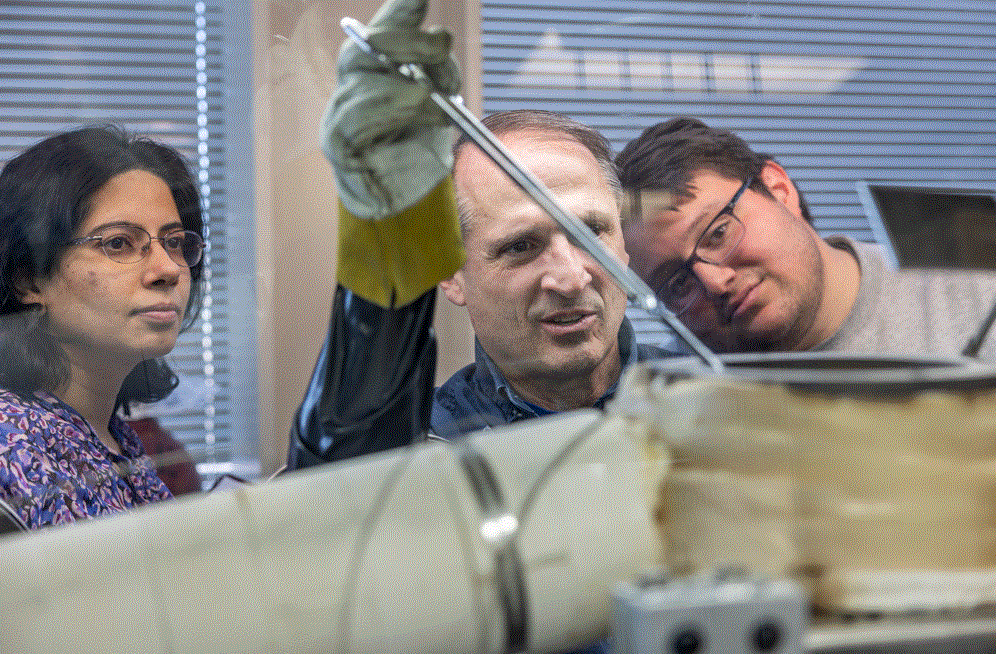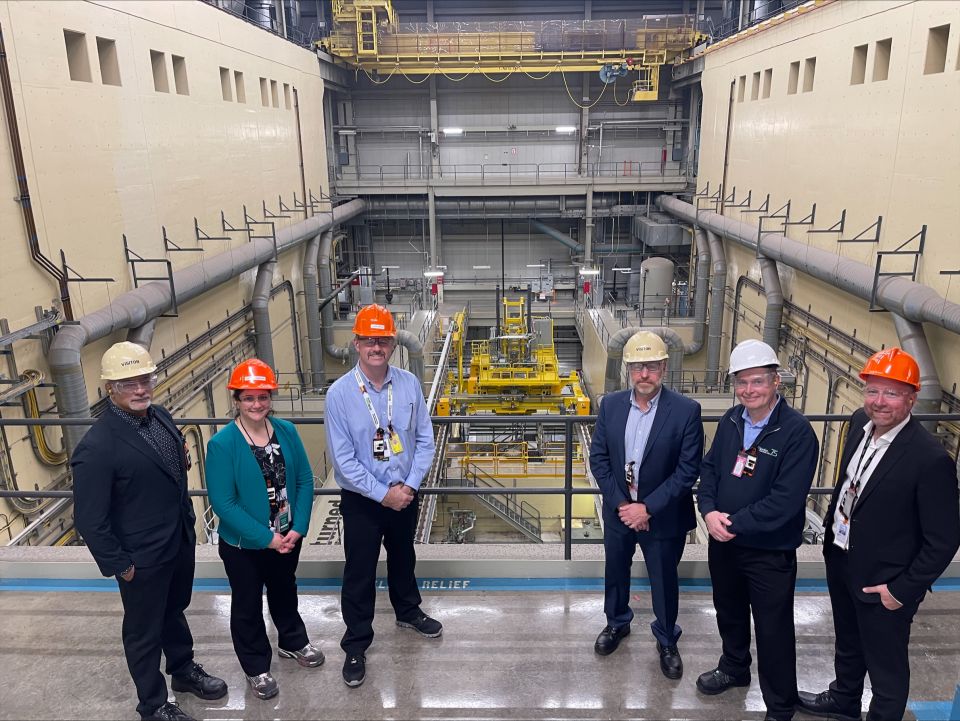ANS Annual Conference special plenary: Our friends the isotopes

“What can the atom do for you, other than produce electricity from nuclear reactors?” That was the question asked and answered during an ANS Annual Conference special plenary session on June 18, introduced by ANS President Ken Petersen and organized by the ANS Young Members Group. An expert panel discussed radioisotopes and their supply chains in the context of cancer treatment, product sterilization, power for remote applications, and used nuclear fuel recycling.
Before the panel took the stage, Petersen awarded ANS Presidential Citations to Christopher M. Crane, former chief executive officer of Exelon (Crane’s posthumous award was accepted by Michael Pacilio, also formerly of Exelon); Stephen E. Kuczynski, of Southern Nuclear; Matthew D. Wargon, of TerraPower; Elizabeth S. Sooby, of the University of Texas–San Antonio; Donald R. Eggett, former chair of the ANS Standards Board; ANS immediate past president Steven A. Arndt, of Oak Ridge National Laboratory; and Miss America 2023 Grace Stanke, of Constellation. Petersen also presented Distinguished Service Awards to Madeline A. Feltus, of the Department of Energy; Kathryn D. Huff, former DOE assistant secretary for nuclear energy and associate professor at the University of Illinois–Urbana-Champaign; and James W. Behrens, of the U.S. Navy (retired).
Petersen then introduced panel moderator Catherine Prat, of Westinghouse Electric Company, who currently serves as the ANS Young Member director on the Board of Directors. “After spending nearly a decade working on the AP1000 power plants in China and the U.S., I have seen the amazing things that this nuclear community can do with uranium-235,” Prat said. “However, there are other isotopes out there, believe it or not, that deserve some love.”
Prat introduced a panel equipped to share the latest developments in radioisotope applications and supply chains: Riaz Bandali, president of Nordion; Ben Goodrich, a director at TerraPower Isotopes; Ross Radel, chief technology officer at SHINE Technologies; Harsh Desai, chief commercialization officer at Zeno Power; and Alyse Huffman, a professional staff member for the Senate Committee on Energy and Natural Resources.
Co-60—a big market getting bigger: Riaz Bandali, president of Nordion, explained that his company focuses on the sterilization of single-use medical devices—a lot of them. “About 40 percent of the single-use medical devices that are used in the U.S., which is about 16 billion devices annually, are actually sterilized using cobalt-60,” he said. But that’s not all that Co-60 can do. It also sterilizes products including spices and labware and is used in stereotactic radiosurgery and “Gamma Knife” treatments for brain cancer.
“Demand for sterilization and the sealed sources that we produced for Co-60 has exceeded supply,” Bandali said. “And so we are right now in the midst of a cycle where we are investing $150 million to increase supply in Canada with our nuclear energy partners, and we are also working with our partner Westinghouse to develop a new technology to partner with some enlightened U.S. utilities to actually produce cobalt in the U.S.” While the United States uses about 50 percent of the world's single-use medical devices annually, it produces no Co-60 of its own, according to Bandali.
“Cancer is the enemy”: Ben Goodrich is a director at TerraPower Isotopes—an emerging supplier of actinium-225 used in targeted radiotherapy cancer treatments. TerraPower is producing its Ac-225 by processing thorium-229 from the DOE that would otherwise be headed for disposal.
“I'm having conversations with household pharmaceutical names regularly at this point, and they're asking me, ‘Hey, Ben, what is TerraPower doing to solidify the market for the future of isotope production? Where are you going to be in 10 to 20 years?’” Goodrich said, adding that “they see the isotope supply chain as being as risky as or more risky than clinical trials themselves.”
“TerraPower was an early adopter of this strategy of ‘cancer is the enemy,’” Goodrich said. “Our competitors are only people that we should be working with in order to solidify the supply chain.” To that end, TerraPower has invested in the Belgian company Pantera, which is using radium-226 in an accelerator to develop Ac-225, to provide redundancy of supply.
From radiotherapy to used fuel recycling: Ross Radel, SHINE’s chief technology officer, talked about the company’s phased system from low-yield fusion systems, producing medical isotopes, to used nuclear fuel recycling. Like TerraPower, SHINE is focused on producing a supply of a radioisotope for targeted radiotherapy, but in this case the isotope of choice is lutetium-177. “As an R&D guy, it has been a bit of a surprise to me the extent to which this is not a technology effort,” Radel said, referring to “that intersection of the technology with the supply and the timing associated with that,” given that Lu-177 has a one-week half-life.
“What we're really zeroing in on is [used nuclear fuel] recycling and especially the isotope harvesting aspect of this,” Radel said. “My day job, if you will, is leading this program and focusing on making nuclear truly renewable, recovering the potential for energy production from that fuel, recycling that to the next generation fuel.” SHINE is working on improving the economics of the process and “the U.S. compliance side of that, so looking at things like keeping the plutonium with the uranium at all times, for example, throughout the cycle.”
Sea to space: Zeno Power wants to market strontium-90 power systems for “austere environments that are hard to reach in space, undersea, and remote Arctic locations.”
Harsh Desai, Zeno’s chief commercialization officer, explained that the United States has deployed over 100 strontium-90 radioisotope power sources before, including in ocean buoys. Zeno Power’s Sr-90 power systems wouldn’t offer power on the scale of plutonium-238 systems that the DOE has produced for NASA, but they could be cheaper and easier to produce. “Plutonium-based systems are your Ferraris,” Desai said. “We're looking to build a bunch of Toyota Corollas.”
Desai said that with “over $60 million in contracts,” Zeno is positioned “to provide and bring this technology to market for space and maritime environments by the 2026 time frame.”
Zeno Power announced in January that it had secured a supply of Sr-90 from ORNL. During the special plenary, Desai announced a new memorandum of understanding with SHINE “to explore isotopes and create a long-term supply chain for our isotopes.”
“As Ross [Radel] mentioned, they're looking at recycling,” Desai continued. “Well, what's going to be considered their trash is really fuel for us. So it really allows us to be part of the entire value chain, close the entire cycle and make sure that all aspects of the recycled material is beneficially used and enabling capabilities for our customers and the country.”
Government perspective: Former ANS Congressional Fellow Alyse Huffman now works for Sen. Joe Manchin (I., W.Va.) on the staff of the Senate Energy and Natural Resources Committee, which has jurisdiction over the DOE and the national laboratories.
“The federal government actually has a pretty big role to play when it comes to isotopes,” Huffman said, with one of the biggest programs being the DOE’s Isotope Program within the Office of Science. “Their mission really is to make sure we have a stable supply of radio and stable isotopes in places where the industry cannot or will not produce them, so they think a lot about making sure that we have a secure supply chain of various isotopes,” Huffman said.
In the fiscal year 2024 appropriations process, $98 million went directly to DOE isotope programs, Huffman said. “I think the Department of Energy is still trying to figure out exactly how it’s going to be used. . . . But really, the whole point of that is to help us reduce our reliance on other countries.”
Co-60 hitches a ride: The DOE has monitored and worked to bolster the domestic supply chain for radioisotopes since before the war in Ukraine drew increased attention to U.S. imports from Russia.
The Prohibiting Russian Uranium Imports Act became law in May, and it limits and eventually bans imports of enriched uranium from Russia. The law didn’t include imports of radioisotopes other than uranium. “However, there are knock-on effects that can happen when you start messing with sanctions and bans, because there are just so many pieces to the supply chain,” Huffman explained. Specialized ships that carry enriched uranium from Russia to the United States also carry shipments of Co-60 at the same time.
“There's only a handful of these special boats in the whole world, and there's only certain shipping routes that they can take. . . . And so there's a concern if we ban the imports of uranium, maybe the producer of that isotope, the shipper, it's not worth it to them to ship to us. And that creates a big problem because we don't have a stockpile of this isotope.”
“The isotopes can probably continue to hitch a ride for the near term,” Huffman continued. “But looking at 2028 we'll have to see. Hopefully we can make up that gap.”
The DOE needs to get out of the game: The panelists discussed the current and future role of the DOE Isotope Program, including cooperation between Nordion and the DOE on weaning the United States off Co-60 supplies from Russia.
“Fifty to 70 percent of our supply on an annual basis comes from Canada, but still today about 20 to 50 percent comes from Russia,” said Bandali. “Less than 10 percent comes from Argentina and from India.”
“My colleagues on this panel are talking about volume that’s probably in the micro-Curie realm,” he added. “When we're dealing with industrial cobalt, we’re talking about mega-Curie realms of volume—into 60 to 80 mega-Curies a year that we process.” Co-60 production requires an 18-month to five-year activation cycle inside a reactor, so increased production has a long lead time. “Given what we need to do in terms of actually scaling up production, we need to get the ability to produce cobalt in [U.S.] pressurized water reactors,” Bandali said.
Goodrich encouraged the DOE to continue to de-risk the development of novel radioisotopes. “TerraPower Isotopes looked at the work that the DOE did to de-risk Ac-225,” he said. “That early work allowed me to go in and say, hey, this has been proven. They actually can use it in drugs.”
Goodrich added, “What can be helpful for industry is to continue to de-risk the front end as has always been envisioned and then to have a turnover right when commercial industry steps up, and [that] is exactly what we're seeing in some of these isotope supply chains.”
Huffman said her hope is that private companies succeed at building a supply chain for radioisotopes like Ac-225 and Lu-177. “When the commercial market is able to produce that isotope, DOE needs to get out of the game,” she said. “They're not in the game to be a producer just because they can.”
More from the ANS Annual Conference:






